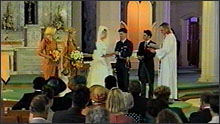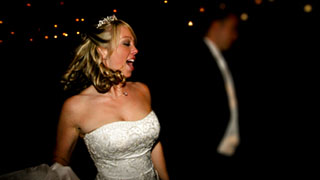Wedding Video Coverage

There are many different ways to cover a wedding, from a simple one-camera operation to an elaborate multi-camera production. It's important to make the right decision on how to approach the video — usually it is a compromise between the highest quality and constraints such as budget, equipment, your experience and logistical considerations.
Naturally, the way you will edit the video will have a bearing on how you shoot it. In-camera editing is a bad idea for weddings — if at all possible you should edit the footage in post-production (for more information see our editing tutorials). If you plan on being professional, post editing is essential.
How many cameras to use?
If you want complete coverage, you will find it difficult with one camera. Things often happen in more than one place at the same time, or you will want shots of different people who are far apart. For example, the bridal procession looks nice interspersed with shots of the groom and congregation watching. This is all but impossible to achieve smoothly with one camera.
It's not hard to move up to two cameras — one of them manned and the other locked off on a wide shot. For example, you could position yourself near the alter with the manned camera and have a static wide shot set up from the back of the church. As you move to a new location (e.g. the reception), begin by setting up the static camera and hit record. You are then free to roam about with the manned camera.
The next improvement would be to have both cameras manned. After that, you could add a third unmanned camera. Three cameras should be ample for most weddings.
Note: Try to use cameras which produce the same type of picture. You will notice that different models have different characteristics such as slightly different colours. This is especially noticeable with different brands of camera. Using the same brand is good, using the same model is even better.
Audio / Microphones
First of all, it's a very good idea to have more than one microphone and recorder. Audio is as important as the video and it will be a disaster if your only audio track is ruined by unexpected hum, interference, wind noise, etc.
If you're keen, you can use radio lapel mics attached to the celebrant, groom and/or bride (although it is often impossible to achieve discretely with the bride). When done properly this creates fantastic audio, but if anything goes wrong you are in trouble unless you have a backup. Another popular option is a mic connected to a minidisc recorder placed in the groom's pocket.
For general audio throughout the day, a reasonably directional mic is best. A mic which is too omni-directional will result in a lot of extraneous noise and make things such as the vows difficult to hear.
On the topic of the vows, these are often very quiet. While the celebrant will probably project their voice well, the bride and groom are likely to speak softly. Make sure your mic will pick them up.
Lighting
 Low light is often a nuisance at weddings but it can also be used to get some nice effects.
Low light is often a nuisance at weddings but it can also be used to get some nice effects.It's unlikely that you will have much control over the lighting. At the planning stage, find out what sort of lighting you will have to deal with. For example, if he ceremony is to be held in front of a giant window you will need to find a suitable position which doesn't have a blown-out (over-exposed) background.
Receptions are often poorly lit from a videographer's point of view. While the low ambient light may be great for mood, your camera might struggle. For this reason, if you are serious about making good wedding videos, make sure you buy cameras which handle low light well.
Staff
Having one or more helpers makes a big difference. Weddings are a lot of work and require you to move and set up equipment as fast as possible. Ideally you would want to hire some staff with video camera experience, but even an inexperienced helper will be very useful.
Next Page: Planning